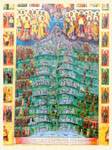|
|
| Portable Icons |
1859 Romanian Skete of St John the Baptist Wood, egg tempera, 98 x 76 cm |
|

|
In the centre is a schematic rendering of the two sides of Mount Athos, divided by a stream that rises just below the peak. On the slopes and the coast are summary representations of the twenty monasteries and the major sketae and kellia, in the form of fortresses. Along the right and left edges of the icon are the founders of the monasteries, Athonite saints, ascetics and hierarchs, mainly depicted in groups, but some individually. On the sea below are sailing vessels and small boats.The area of the sky is occupied by the Virgin and the Holy Trinity in the middle, with the choirs of archangels and apostles on the left and right respectively. This central theme is surrounded on three sides above, right and left by small panels containing figures of saints in groups of two or three. Along the top are Sts Constantine and Helen, St John the Baptist, the Virgin Hodegetria, the Virgin Gorgoepikoos, St Nicholas, St Theodosios and St Pulcheria. The two vertical sections are occupied mainly by Romanian saints `from Wallachia', according to the inscriptions. On the left are St John of Wallachia and St Philautia; Sts Andronikos, Tarachos and Probos; Andrew and Andronikos; Paisios and Metrophanis; John and Gregory, Daniel and Epiphanios. On the right are four pairs of unidentifiable saints, with Sts Demetrios and Nikodemos and Innocent and Euthymios below them. The last two panels are occupied by St George the Great Martyr on the left and St George of Ioannina on the right. The inscriptions identifying the buildings are in Romanian, in Cyrillic script; those accompanying the saints are in Greek, as is the painter's signature: `by the hand of Gennadios the monk'. On an open scroll at the bottom is the dedicatory inscription, with the year 1859. Most of the inscription is in Romanian, in Cyrillic script, the end of it being in Greek: ΔI EΠICTACIAC TOY OCIOTATOY KYPIOY KYPIOY [ANDRONIC] MOYΛΔOBANOYΛ EK THC CKHTEΩC KOYTΛOYMOYCIOY.. Freely translated, the inscription reads: `I have depicted beside Mount Athos, not with many words, divine pearls which grew from the land of little Modloromania. These (the saints depicted) were human beings, too, but not like my humble self. Jesus my Saviour, with the intercession of these saints, forgive your servant. 1859. During the stewardship of the Kyr Andronic Muldanovul of the skete of Koutloumousiou.' The name Andronic in the Greek part of the inscription has been obliterated, but may be restored from the acrostic in the main part. This may have something to do with the controversy which arose regarding the status of the skete in the second half of the nineteenth century (Smyrnakis 1903, pp. 421ff.). The main motif in this icon is usually seen in eighteenth- and nineteenth-century copperplate engravings (Papastratou 1986, pp. 385ff. See also 4.2-4.4 of this catalogue), though it is also found in monumental painting, as in the kyriakon of this same Roman skete (1866). As regards its manner and technique, this work by Gennadios, who is known to have painted other icons on Mount Athos, displays a folk style typical of Athonite painting between the end of the eighteenth and the middle of the nineteenth century, before elements of Western (particularly Nazarene) art penetrated Athos (Cf. Georgiadou-Kountoura 1984, pp. 22ff.).
| |
|
Bibliography: Unpublished.
| ||
| T.N.P. | ||
| Index of exhibits of Skete of St. John the Baptist (Dependency of the Great Lavra) 19th century |
||
Reference address : https://www.elpenor.org/athos/en/e218ab136.asp